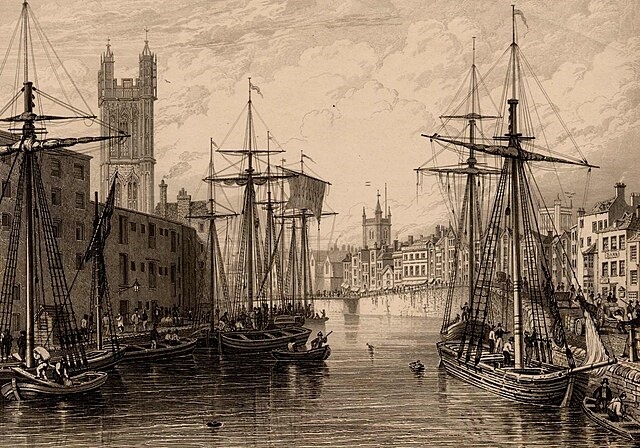For my novel ‘Easter At Netherfield’, published in January, I had to do quite a lot of research into the history of the Port of Bristol which was immensely interesting. I consulted many sites on the subject of Bristol and routes to Bristol whither Mary Bennet absconds with a view to sailing to America after her father refuses to sign a Deed of Guardianship in favour of Adolphus Barrant. The sites consulted are far too numerous to list. I am not familiar with Bristol and ended up spending several days researching the town, maps of the town, the Georgian House, the history of Bristol, its topography, its tides, the phases of the moon (including in relation to the previous intention to sail from London), its coaching inns and other buildings et cetera and also whether it would have been practicable for Mary’s family to have applied for a Writ of Habeas Corpus. Probably not seemed to be the answer.
The description of Broad Quay in Easter At Netherfield’ was derived from a piece about Bristol Docks on a site called brisray.com which included a beautiful, brilliantly colourful painting said to be of the late eighteenth century attributed to Philip Vandyke according to the site. Another site, mediastorehouse.com, also included a description of the painting and puts the date circa 1760 by an artist from the British School. The painting is said to be housed at the Bristol Museum and Art Gallery.
I read in a study shortly entitled ‘The port of Bristol in the second half of the eighteenth century’ by John Gilbert MacMillan that a diary of winds and tides of Bristol from March 1792 to March 1793 showed that on 241 days of the year or 68% of the year ships could not leave the harbour due to the conditions. I had to worry therefore that my small party consisting of Mary Bennet, Adolphus Barrant and Bernard the footman in Bristol in April 1799 hoping to board a ship for America might have found it impossible to do so. It was thought to be due mainly to ‘neap’ tides, (that is tides which occur when the sun, moon, and Earth form a right angle, and this causes the regular high tides and low tides to become much lower than usual) but also to the long winding river down to the sea being particularly vulnerable to wind and tide and any strong wind between south and west.
However, the British Archives Online Bristol Shipping Records: Imports & Exports, 1770 to 1917 (for which I had to pay a temporary subscription) did include details of a few transatlantic sailings from Bristol in April 1799 to Quebec, Jamaica, possibly Charleston (the record isn’t very clear), Antigua, Newfoundland and New York so hopefully my small party would not have been stranded in Bristol for too long. But there were a lot of other sailings to Ireland so Adolphus Barrant & Co could possibly have travelled via Ireland in the first instance.
There’s a lot more to say about Bristol. A ‘floating harbour’ was created where the water level remained constant to prevent the very low tides affecting shipping, however this was in 1809, therefore some years after 1799 in which my books is set. Later, deepwater docks were created and the Bristol City Docks in the floating harbour became redundant for larger ships.
Sadly, without being sure of the copyright status of the Broad Quay painting, I wasn’t able to include it in this post, therefore the attached image from Wikipedia is of the Bristol Harbour circa 1850 which Wikipedia says is in the public domain.


Recent Comments